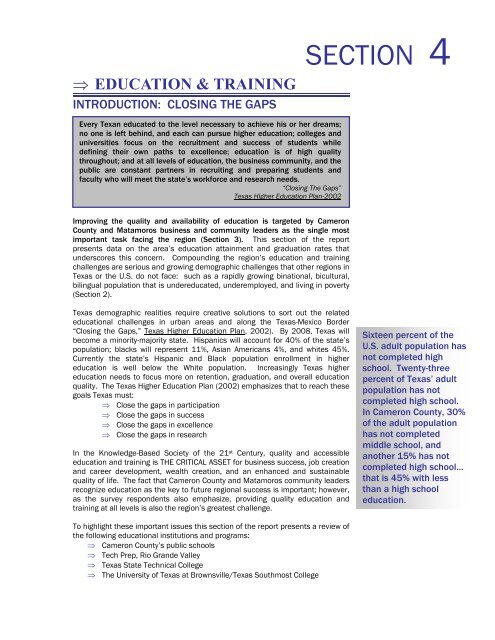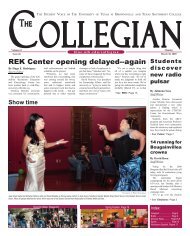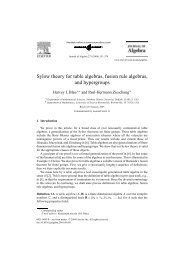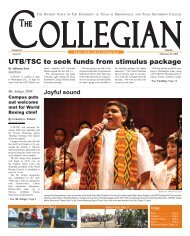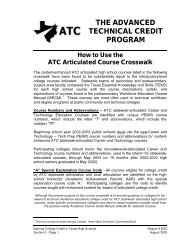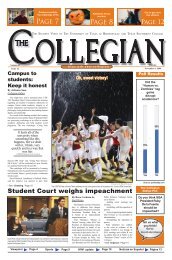cameron county/matamoros - blue - The University of Texas at ...
cameron county/matamoros - blue - The University of Texas at ...
cameron county/matamoros - blue - The University of Texas at ...
You also want an ePaper? Increase the reach of your titles
YUMPU automatically turns print PDFs into web optimized ePapers that Google loves.
⇒ EDUCATION & TRAINING<br />
INTRODUCTION: CLOSING THE GAPS<br />
Every Texan educ<strong>at</strong>ed to the level necessary to achieve his or her dreams;<br />
no one is left behind, and each can pursue higher educ<strong>at</strong>ion; colleges and<br />
universities focus on the recruitment and success <strong>of</strong> students while<br />
defining their own p<strong>at</strong>hs to excellence; educ<strong>at</strong>ion is <strong>of</strong> high quality<br />
throughout; and <strong>at</strong> all levels <strong>of</strong> educ<strong>at</strong>ion, the business community, and the<br />
public are constant partners in recruiting and preparing students and<br />
faculty who will meet the st<strong>at</strong>e’s workforce and research needs.<br />
“Closing <strong>The</strong> Gaps”<br />
<strong>Texas</strong> Higher Educ<strong>at</strong>ion Plan-2002<br />
Improving the quality and availability <strong>of</strong> educ<strong>at</strong>ion is targeted by Cameron<br />
County and M<strong>at</strong>amoros business and community leaders as the single most<br />
important task facing the region (Section 3). This section <strong>of</strong> the report<br />
presents d<strong>at</strong>a on the area’s educ<strong>at</strong>ion <strong>at</strong>tainment and gradu<strong>at</strong>ion r<strong>at</strong>es th<strong>at</strong><br />
underscores this concern. Compounding the region’s educ<strong>at</strong>ion and training<br />
challenges are serious and growing demographic challenges th<strong>at</strong> other regions in<br />
<strong>Texas</strong> or the U.S. do not face: such as a rapidly growing bin<strong>at</strong>ional, bicultural,<br />
bilingual popul<strong>at</strong>ion th<strong>at</strong> is undereduc<strong>at</strong>ed, underemployed, and living in poverty<br />
(Section 2).<br />
<strong>Texas</strong> demographic realities require cre<strong>at</strong>ive solutions to sort out the rel<strong>at</strong>ed<br />
educ<strong>at</strong>ional challenges in urban areas and along the <strong>Texas</strong>-Mexico Border<br />
“Closing the Gaps,” <strong>Texas</strong> Higher Educ<strong>at</strong>ion Plan, 2002). By 2008, <strong>Texas</strong> will<br />
become a minority-majority st<strong>at</strong>e. Hispanics will account for 40% <strong>of</strong> the st<strong>at</strong>e’s<br />
popul<strong>at</strong>ion; blacks will represent 11%, Asian Americans 4%, and whites 45%.<br />
Currently the st<strong>at</strong>e’s Hispanic and Black popul<strong>at</strong>ion enrollment in higher<br />
educ<strong>at</strong>ion is well below the White popul<strong>at</strong>ion. Increasingly <strong>Texas</strong> higher<br />
educ<strong>at</strong>ion needs to focus more on retention, gradu<strong>at</strong>ion, and overall educ<strong>at</strong>ion<br />
quality. <strong>The</strong> <strong>Texas</strong> Higher Educ<strong>at</strong>ion Plan (2002) emphasizes th<strong>at</strong> to reach these<br />
goals <strong>Texas</strong> must:<br />
⇒ Close the gaps in particip<strong>at</strong>ion<br />
⇒ Close the gaps in success<br />
⇒ Close the gaps in excellence<br />
⇒ Close the gaps in research<br />
In the Knowledge-Based Society <strong>of</strong> the 21 st Century, quality and accessible<br />
educ<strong>at</strong>ion and training is THE CRITICAL ASSET for business success, job cre<strong>at</strong>ion<br />
and career development, wealth cre<strong>at</strong>ion, and an enhanced and sustainable<br />
quality <strong>of</strong> life. <strong>The</strong> fact th<strong>at</strong> Cameron County and M<strong>at</strong>amoros community leaders<br />
recognize educ<strong>at</strong>ion as the key to future regional success is important; however,<br />
as the survey respondents also emphasize, providing quality educ<strong>at</strong>ion and<br />
training <strong>at</strong> all levels is also the region’s gre<strong>at</strong>est challenge.<br />
To highlight these important issues this section <strong>of</strong> the report presents a review <strong>of</strong><br />
the following educ<strong>at</strong>ional institutions and programs:<br />
⇒ Cameron County’s public schools<br />
⇒ Tech Prep, Rio Grande Valley<br />
⇒ <strong>Texas</strong> St<strong>at</strong>e Technical College<br />
⇒ <strong>The</strong> <strong>University</strong> <strong>of</strong> <strong>Texas</strong> <strong>at</strong> Brownsville/<strong>Texas</strong> Southmost College<br />
SECTION 4<br />
Sixteen percent <strong>of</strong> the<br />
U.S. adult popul<strong>at</strong>ion has<br />
not completed high<br />
school. Twenty-three<br />
percent <strong>of</strong> <strong>Texas</strong>’ adult<br />
popul<strong>at</strong>ion has not<br />
completed high school.<br />
In Cameron County, 30%<br />
<strong>of</strong> the adult popul<strong>at</strong>ion<br />
has not completed<br />
middle school, and<br />
another 15% has not<br />
completed high school…<br />
th<strong>at</strong> is 45% with less<br />
than a high school<br />
educ<strong>at</strong>ion.


